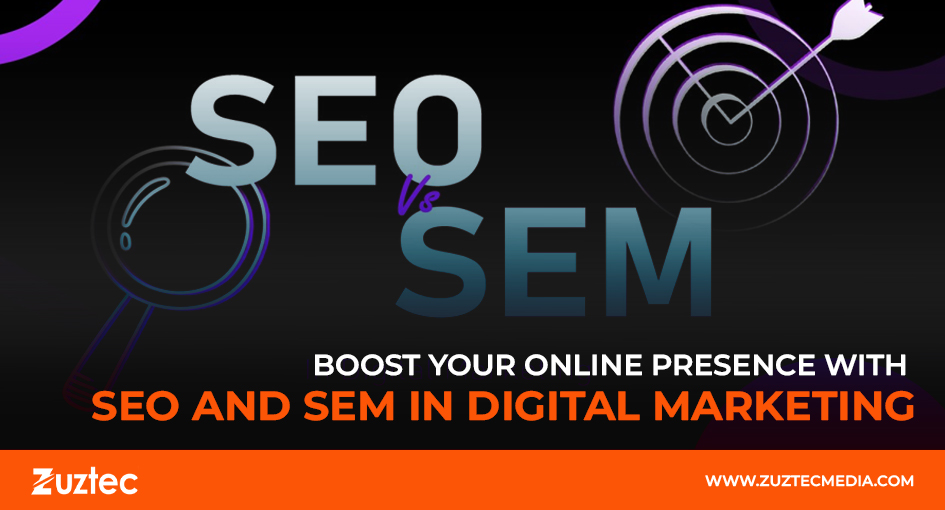
Boost Your Online Presence with SEO and SEM in Digital Marketing
In the ever-evolving world of online business, visibility is everything. With countless companies competing to grab the attention of potential customers, having a strong and consistent presence on search engines has become more critical than ever. Businesses today must adapt to the digital-first approach, where standing out in search engine results can significantly impact their ability to attract new customers and drive growth. This is where SEO and SEM in digital marketing come into play, offering businesses the tools to enhance their visibility, generate qualified traffic, and ultimately boost conversions.
Search Engine Optimization (SEO) focuses on improving a website’s organic search rankings through techniques like content optimization, technical improvements, and enhancing the user experience. Meanwhile, Search Engine Marketing (SEM) uses paid strategies like pay-per-click (PPC) advertising to ensure your business appears at the top of search engine results pages (SERPs). Together, these complementary approaches create a powerful synergy that helps businesses thrive in an increasingly competitive digital environment.
By leveraging the strengths of both SEO and SEM, businesses can achieve both immediate and long-term success, securing more visibility, engaging the right audiences, and driving meaningful results. In this article, we’ll explore the unique benefits of integrating SEO and SEM in digital marketing and how these strategies can help propel your business forward.
SEO and SEM in Digital Marketing: The Role of SEO in Digital Marketing
Search Engine Optimization (SEO) is a long-term strategy that focuses on improving a website’s organic rankings on search engines like Google, Bing, and Yahoo. It encompasses several key components:
- Keyword Optimization:
Identifying and strategically using keywords relevant to your business to rank higher in search queries.
- Content Quality:
Producing valuable, informative, and engaging content that attracts and retains users.
- Technical SEO:
Ensuring that both visitors and search engines can easily navigate your website and that it is quick and responsive.
- Link Building:
Earning backlinks from authoritative websites to build credibility and boost rankings.
By investing in SEO, businesses can enhance their organic visibility, build trust with their audience, and establish themselves as industry leaders. However, the results of SEO efforts may take time to show, making it essential to combine it with SEM for immediate impact.
How SEM Complements SEO in Digital Marketing
While SEO focuses on organic growth, Search Engine Marketing (SEM) delivers faster results by using paid advertising strategies to drive traffic. Platforms like Google Ads and Bing Ads allow businesses to bid for ad placements on SERPs, ensuring they appear at the top of search results for specific keywords.
Here’s how SEM complements SEO:
- Immediate Visibility:
SEM helps businesses appear at the top of search results instantly, even for competitive keywords that might take months to rank for organically through SEO.
- Targeted Reach:
Paid ads enable businesses to target specific demographics, locations, and interests, ensuring that the right audience sees their message.
- Performance Tracking:
SEM campaigns provide detailed analytics, helping businesses track clicks, impressions, and conversions in real time.
- A/B Testing:
SEM allows businesses to experiment with different ad formats and messaging to identify what resonates best with their audience.
By combining SEO and SEM, businesses can cover both short-term and long-term goals, ensuring they maximize their presence on search engines while building sustainable growth.
The Benefits of Using SEO and SEM in Digital Marketing
When integrated effectively, SEO and SEM in digital marketing can deliver impressive results for your digital marketing strategy. Here are a few of the main advantages of SEO and SEM.
- Increased Online Visibility:
With both organic and paid strategies in place, your business can dominate search engine results, making it more likely for users to click on your links.
- Higher Website Traffic:
SEO drives consistent traffic over time, while SEM boosts immediate traffic, resulting in a steady flow of visitors to your site.
- Enhanced Credibility and Trust:
A strong organic presence through SEO builds trust, while SEM ads reinforce your brand’s authority by appearing at the top of SERPs.
- Improved ROI:
Both strategies target users actively searching for your products or services, increasing the likelihood of conversions and delivering a higher return on investment.
- Comprehensive Data Insights:
Combining SEO and SEM provides a wealth of data about user behavior, search trends, and campaign performance, helping you refine your strategy.
How to Effectively Integrate SEO and SEM
To get the most out of SEO and SEM in digital marketing, it’s essential to approach them as complementary, rather than separate, strategies. Here’s how you can effectively integrate the two:
- Perform Thorough Keyword Research:
Identify keywords that align with your business goals and create a unified plan for targeting them through both organic and paid efforts.
- Optimize Landing Pages:
Ensure that the landing pages for your paid ads are optimized for SEO to improve user experience and drive conversions.
- Leverage Remarketing:
Use SEM to retarget users who have previously visited your site but didn’t convert, while optimizing SEO to bring in new traffic.
- Align Content Strategies:
Create content that targets both organic and paid search intent, ensuring consistency across campaigns.
- Monitor and Adjust:
Use analytics tools to track the performance of your SEO and SEM efforts, identifying areas for improvement and adapting your strategy as needed.
To sum up, in today’s competitive digital landscape, businesses must leverage every tool at their disposal to stand out and succeed. By integrating SEO and SEM in digital marketing, you can create a powerful strategy that drives both immediate results and long-term growth. While SEO ensures your website is optimized for organic visibility, SEM helps you capture the attention of potential customers quickly and efficiently.
When these two strategies work together, they provide a comprehensive approach to online marketing, enhancing your brand’s presence, driving targeted traffic, and increasing conversions. Whether you’re a small business or a large enterprise, investing in SEO and SEM is essential for achieving sustainable success in the digital age. Start combining these strategies today and watch your online presence soar!

